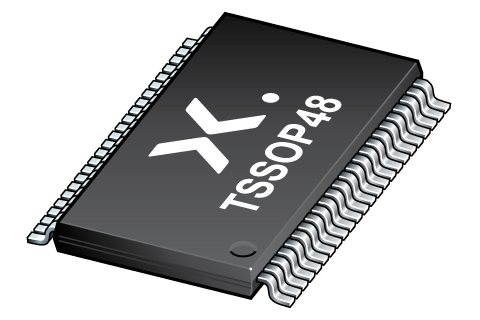
Register once, drag and drop ECAD models into your CAD tool and speed up your design.
Click here for more information74ALVCH16373DL
2.5 V/3.3 V 16-bit D-type transparent latch; 3-state
The 74ALVCH16373 is a 16-bit D-type transparent latch with bus hold inputs and 3-state outputs. The device can be used as two 8-bit transparent latches or a single 16-bit transparent latch. The device features two latch enables (1LE and 2LE) and two output enables (1OE and 2OE), each controlling 8-bits. When nLE is HIGH, data at the inputs enter the latches. In this condition the latches are transparent, a latch output will change each time its corresponding D-input changes. When nLE is LOW the latches store the information that was present at the inputs a set-up time preceding the HIGH-to-LOW transition of nLE. A HIGH on nOE causes the outputs to assume a high-impedance OFF-state. Operation of the nOE input does not affect the state of the latches.
This device is fully specified for partial power down applications using IOFF. The IOFF circuitry disables the output, preventing the potentially damaging backflow current through the device when it is powered down.
Alternatives
Features and benefits
Wide supply voltage range from 1.2 V to 3.6 V
CMOS low power dissipation
MULTIBYTE™ flow-through standard pin-out architecture
Low inductance multiple VCC and GND pins for minimum noise and ground bounce
Direct interface with TTL levels
All data inputs have bus hold
Latch-up performance exceeds 100 mA per JESD78 Class II.A
Output drive capability 50 Ω transmission lines at 85 °C
Current drive ±24 mA at VCC = 3.0 V
-
Complies with JEDEC standards:
JESD8-7 (1.65 V to 1.95 V)
JESD8-5 (2.3 V to 2.7 V)
JESD8C/JESD36 (2.7 V to 3.6 V)
ESD protection:
- HBM ANSI/ESDA/JEDEC JS-001 Class 2 exceeds 2 kV
- CDM ANSI/ESDA/JEDEC JS-002 Class C3 exceeds 1 kV
- Specified from -40 °C to +85 °C and from -40 °C to +125 °C
Parametrics
| Type number | Product status | Package name |
|---|---|---|
| 74ALVCH16373DL | End of life | SSOP48 |
Package
All type numbers in the table below are discontinued. See the table Discontinuation information for more information.
| Type number | Orderable part number, (Ordering code (12NC)) | Status | Marking | Package | Package information | Reflow-/Wave soldering | Packing |
|---|---|---|---|---|---|---|---|
| 74ALVCH16373DL | 74ALVCH16373DL,112 (935260443112) |
Obsolete | ALVCH16373 Standard Procedure Standard Procedure |

SSOP48 (SOT370-1) |
SOT370-1 |
SSOP-TSSOP-VSO-REFLOW
SSOP-TSSOP-VSO-WAVE |
Not available |
| 74ALVCH16373DL,118 (935260443118) |
Obsolete | ALVCH16373 Standard Procedure Standard Procedure | SOT370-1_118 |
Environmental information
All type numbers in the table below are discontinued. See the table Discontinuation information for more information.
| Type number | Orderable part number | Chemical content | RoHS | RHF-indicator |
|---|---|---|---|---|
| 74ALVCH16373DL | 74ALVCH16373DL,112 | 74ALVCH16373DL |
|
|
| 74ALVCH16373DL | 74ALVCH16373DL,118 | 74ALVCH16373DL |
|
|
Series
Documentation (6)
| File name | Title | Type | Date |
|---|---|---|---|
| 74ALVCH16373 | 2.5 V/3.3 V 16-bit D-type transparent latch; 3-state | Data sheet | 2021-11-22 |
| alvch16373 | alvch16373 IBIS model | IBIS model | 2013-04-07 |
| Nexperia_package_poster | Nexperia package poster | Leaflet | 2020-05-15 |
| SOT370-1 | plastic, shrink small outline package; 48 leads; 0.635 mm pitch; 15.9 mm x 7.5 mm x 2.8 mm body | Package information | 2020-04-21 |
| SSOP-TSSOP-VSO-REFLOW | Footprint for reflow soldering | Reflow soldering | 2009-10-08 |
| SSOP-TSSOP-VSO-WAVE | Footprint for wave soldering | Wave soldering | 2009-10-08 |
Support
If you are in need of design/technical support, let us know and fill in the answer form we'll get back to you shortly.
Models
| File name | Title | Type | Date |
|---|---|---|---|
| alvch16373 | alvch16373 IBIS model | IBIS model | 2013-04-07 |
How does it work?
The interactive datasheets are based on the Nexperia MOSFET precision electrothermal models. With our interactive datasheets you can simply specify your own conditions interactively. Start by changing the values of the conditions. You can do this by using the sliders in the condition fields. By dragging the sliders you will see how the MOSFET will perform at the new conditions set.

